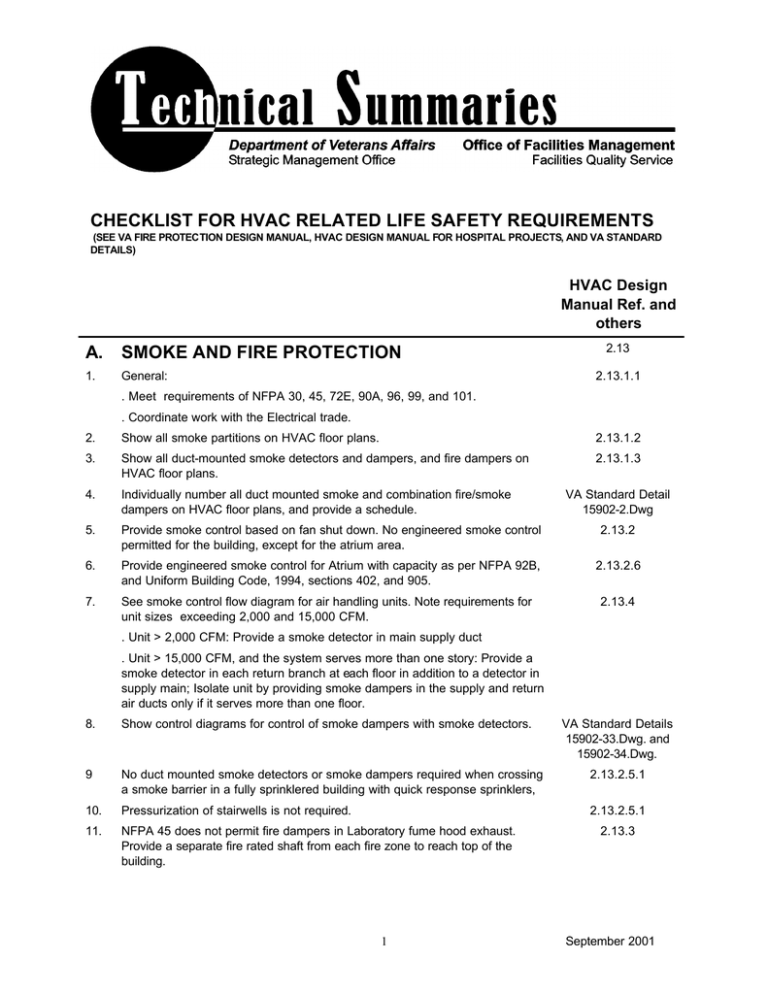CHECKLIST FOR HVAC RELATED LIFE SAFETY REQUIREMENTS
advertisement

CHECKLIST FOR HVAC RELATED LIFE SAFETY REQUIREMENTS (SEE VA FIRE PROTECTION DESIGN MANUAL, HVAC DESIGN MANUAL FOR HOSPITAL PROJECTS, AND VA STANDARD DETAILS) HVAC Design Manual Ref. and others A. SMOKE AND FIRE PROTECTION 1. General: 2.13 2.13.1.1 . Meet requirements of NFPA 30, 45, 72E, 90A, 96, 99, and 101. . Coordinate work with the Electrical trade. 2. Show all smoke partitions on HVAC floor plans. 2.13.1.2 3. Show all duct-mounted smoke detectors and dampers, and fire dampers on HVAC floor plans. 2.13.1.3 4. Individually number all duct mounted smoke and combination fire/smoke dampers on HVAC floor plans, and provide a schedule. 5. Provide smoke control based on fan shut down. No engineered smoke control permitted for the building, except for the atrium area. 2.13.2 6. Provide engineered smoke control for Atrium with capacity as per NFPA 92B, and Uniform Building Code, 1994, sections 402, and 905. 2.13.2.6 7. See smoke control flow diagram for air handling units. Note requirements for unit sizes exceeding 2,000 and 15,000 CFM. VA Standard Detail 15902-2.Dwg 2.13.4 . Unit > 2,000 CFM: Provide a smoke detector in main supply duct . Unit > 15,000 CFM, and the system serves more than one story: Provide a smoke detector in each return branch at each floor in addition to a detector in supply main; Isolate unit by providing smoke dampers in the supply and return air ducts only if it serves more than one floor. 8. Show control diagrams for control of smoke dampers with smoke detectors. 9 No duct mounted smoke detectors or smoke dampers required when crossing a smoke barrier in a fully sprinklered building with quick response sprinklers, 2.13.2.5.1 10. Pressurization of stairwells is not required. 2.13.2.5.1 11. NFPA 45 does not permit fire dampers in Laboratory fume hood exhaust. Provide a separate fire rated shaft from each fire zone to reach top of the building. 1 VA Standard Details 15902-33.Dwg. and 15902-34.Dwg. 2.13.3 September 2001 HVAC Design Manual Ref. and others 12. Provide smoke venting for elevator shafts. When standby power is connected to an elevator, NFPA 101 requires the machine room ventilation/air conditioning system also to be connected to standby power. VA Standard Detail 15902-32-Dwg. 13. Per NFPA 90A, the following hazardous exhaust ducts shall not be housed in the same shaft carrying environmental supply, return or exhaust ducts: 2.11.2.2 Exhaust from fume hoods, ETO sterilizers, kitchen grease laden hoods, ortho/prosthetic lab, and battery charging rooms. 14. Per NFPA 30, provide a dedicated exhaust system for each flammable and combustible liquid storage space. Provide an explosion proof motor and spark proof fan, and flow monitoring and alarm system. 15. Conform kitchen hood exhaust to NFPA 96. 4.5 3.12.7.1 and VA Master Spec Section 15250. B. EMERGENCY POWER 2.16 1. Where outdoor winter design temperature is -6.5 degrees C (20 degrees F) or less, provide building heating equipment on emergency power as required by NFPA 99. 2.16 2. Exhaust fans serving labs, emergency generator rooms, , ETO exhaust, Xenon and Iodine gases, battery charging rooms, flammable storage rooms, Atrium smoke control, and HVAC equipment serving critical areas of OPCs in seismic and high risk hurricane areas etc.. 2.16 C. LEAD LINING OF DUCT WORK 3.19.2 1. 3.19.2 Provide lead lining on ductwork penetrating lead lined walls. 4.12 D. SPECIAL VENTILATION 1. Radioactive Xenon gas and iodine require special exhaust system. 2 September 2001 HVAC Design Manual Ref. and others E. REFRIGERATION SYSTEMS FOR AIR – CONDITIONING 1. Follow ASHRAE standard 15-94 for personnel safety in chiller rooms. VA allows use of HCFC -123, HFC -134a, and HCFC - 22 refrigerants for its chillers. F. MAINTENANCE OF MECHANICAL EQUIPMENT 1. Provide guards, handrails, ladders, and platforms for maintenance to meet OSHA requirements. 2.12 VA Design Alert FM-187C-DA8 “ G. SEISMIC REQUIREMENTS 2.15 1. See VA Construction Standard CD-54, VA Handbook H-18-8, and Uniform Building Code. 2.15 2. Provide seismic restraints for equipment where ‘Z’ value is equal or greater than 0.10. Comply with local code if there are more stringent requirements. 2.15.1.2 3. Provide seismic bracing of piping and ductwork where ‘Z’ value is equal or greater than 0.20. Comply with local code requirements if there are more stringent requirements. 2.15.1.2 4. Z values of various VA medical Centers are listed in VA Handbook H-18-8. Verify these values before proceeding on a specific project. 2.15.1.2 5. VA allows use of SMACNA or NUSIG details for seismic bracing. 2.15.2 and 2.15.3 Contact Satish Sehgal at 202-565-5032, Kurt Knight at 202-565-4663, Don Walden 202-565-5014 or Sat Gupta at 202-565-5268 for additional information. 3 September 2001

